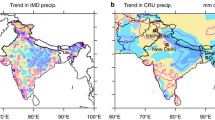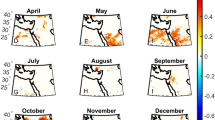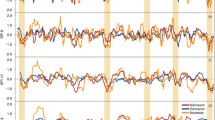Abstract
Bolivia is located at the crossroad of the major climatic influences of Northern and Southern-South America, which turns this country into a natural laboratory to investigate the interactions between ocean-climate and fire variability. We chose two oceanic indices: MEI (multivariate ENSO Index) and AMO (Atlantic Multidecadal Oscillation) to select the three most representative years for four oceanic conditions: El Niño, La Niña, AMO, and standard years (understood as years with little ocean influences), for the period 1992–2012. We investigated how i) rainfall (dry vs wet seasons) and ii) fire responded in five Bolivian biomes (Tropical Moist Forests, Tropical Dry Forests, Tropical Grasslands, Tropical Montane, and Seasonally Flooded ecosystems) under these oceanic conditions. Bolivia showed a strong rainfall increase in El Niño years in both seasons (wet/dry), while AMO showed the strongest droughts in both seasons. La Niña showed a bipolar response with rainfall increases in the wet season and a very marked rainfall decrease in the dry season. Drought significantly increased fire numbers in AMO years, being the most significant fire condition and suggesting a larger fire influence of the Atlantic than the Pacific at the national level. Surprisingly, the amount of fire was very large under normal years (STD) and similar to fire levels under La Niña, suggesting generalized fire conditions in the country, except for El Niño years that bring rainfall excess and little fire. The most fire-affected biomes were the seasonally flooded and dry forests, followed by the grassland/savannah biome. Montane areas showed the least fire, but satellite fire omission is well known in the Andean region.



Similar content being viewed by others
References
Aceituno P (1988) On the functioning of the Southern Oscillation in the South American sector. Part I. Climate sector. Mon Weather Rev 116:505–524
Aceituno P, Garreaud R (1995) The impact of ENSO phenomenon on rainfall regimes along the Andes cordillera. Rev Chil Ing Hidráulica 2:33–43
Aragaõ LE, Malhi Y, Roman-Cuesta RM et al (2007) Spatial patterns and fire response of recent Amazonian droughts. Geophys Res Lett 34, L07701
Armenteras DA, Retana J, Molowny-Horas R et al (2011) Characterising fire spatial pattern interactions with climate and vegetation in Colombia. Agric For Meteorol 151:279–289
Barlow J, Peres C (2008) Fire mediated dieback and compositional cascade in an Amazonian forest. Philos Trans R Soc B 363:1787–1794
Bradley AV, Millington AC (2006) Spatial and temporal scale issues in determining biomass burning. Int J Remote Sens 27:2221–2253
Bradley R, Vuille M, Díaz H, Vergara W (2006) Threats to water supplies in the tropical Andes. Science 312:1755–1756
Chen Y, Randerson J, Morton D et al (2011) Forecasting fire season severity in South America using sea surface temperature anomalies. Science 334:787–791
Chen Y, Morton D, Jin Y et al (2013) Long-term trends and interannual variability of forest, savanna and agricultural fires in South America. Carbon Manag 4:617–638
Cochrane M, Laurence W (2002) Fire as a large-scale edge effect in Amazonian forests. J Trop Ecol 18:311–325
Cochrane MA, Alencar A, Schulze MD et al (1999) Positive feedbacks in the fire dynamic of closed canopy tropical forests. Science 284:1832–1835
Cox PM, Harris PP, Huntingford C et al (2008) Increasing risk of Amazonian drought due to decreasing aerosol pollution. Nature 453:212–215
Dai A, Trenberth KE (1998) Global variations in droughts and wet spell: 1900–1995. Geophys Res Lett 25:3367–3370
Enfield DB, Mestas-Nunez AM, Trimble PJ (2001) The Atlantic Multidecadal Oscillation and its relationship to rainfall and river flows in the continental U.S. Geophys Res Lett 28:2077–2080
Fernandes K, Baethgen W, Bernades S et al (2011) North Tropical Atlantic influence on western Amazon fire season variability. Geophys Res Lett 38, L12701
Garreaud R (2000) Intraseasonal variability of moisture and rainfall over the South American Altiplano. Mon Weather Rev 128:3337–3346
Garreaud R, Aceituno P (2001) Interannual rainfall variability over the South American Altiplano. J Clim 14:2779–2789
Gonzalez P, Goddard L, Greene A (2012) Twentieth-century summer precipitation in South Eastern South America: comparison of gridded and station data. Int J Climatol. doi:10.1002/joc.3633
Grimm A, Ferraz S, Gomes J (1998) Precipitation anomalies in Southern Brazil associated with El Niño and La Niña events. J Clim 12:1306–1321
Harris I, Jones P, Osborn T, Lister D (2013) Updated high-resolution grids of monthly climatic observations - the CRU TS3.10 dataset. Int J Climatol. doi:10.1002/joc.3711
Kerr R (2000) A north Atlantic climate pacemaker for the centuries. Science 288:1984–1986
Killeen T, Douglas M, Consiglio T et al (2007) Dry spots and wet spots in the Andean hotspot. J Biogeogr 34:1357–1373
Kitzberger T, Swetnam T, Veblen T (2001) Inter-hemispheric synchrony of forest fires and the El Niño-Southern Oscillation. Glob Ecol Biogeogr 10:315–326
Kitzberger T, Brown P, Heyerdahl E et al (2007) Contingent Pacific-Atlantic Ocean Influence on multicentury wildfire synchrony over western North America. PNAS 104:543–548
Lenton T (2011) Early warning of climate tipping points. Nat Clim Chang 1:201–209
Lewis SL, Brando PM, Phillips OL et al (2011) The 2010 Amazon drought. Science 331:554
Liebmann B, Vera C, Carvalho L et al (2004) An observed trend in Central South American precipitation. J Clim 17:4357–4367
Malhi Y, Roberts JT, Betts RA et al (2008) Climate change, deforestation, and the fate of the Amazon. Science 319:169–172
Marengo J, Soares W, Saulo C, Nicolini M (2004) Climatology of the low-level jet east of the Andes as derived from the NCEPNCAR reanalyses: characteristics and temporal variability. J Clim 17:2261–2280
Marengo JA, Nobre CA, Tomasella J (2008) The drought of Amazonia in 2005. J Clim 21:495–516
Marengo JA, Tomasella J, Alves LM, et al (2011) The drought of 2010 in the context of historical droughts in the Amazon region. Geophys Res Lett 38, L12703
Marengo JA, Tomasella J, Soares W et al (2012) Extreme climatic events in the Amazon basin. Climatological and hydrological context of recent floods. Theor Appl Climatol 107:73–85
Miranda C, Beck S (2003) La conservación de ecosistemas transfronterizos—El desafío peruano-boliviano en las vertientes orientales de los Andes y llanuras adyacentes. Lyonia 4:165–182
Montecinos A, Díaz A, Aceituno P (2000) Seasonal diagnostic and predictability of rainfall in subtropical South America based on tropical Pacific SST. J Clim 13:746–758
Myers N, Mittermeier R, Mittermeier C et al (2000) Biodiversity hotspots for conservation priorities. Nature 403:853–858
Nogués-Paegle J, Mechoso C, Fu R et al (2002) Understanding the South American monsoon. Prog Pan Am Clim 27:1–30
Oliveras I, Anderson L, Malhi Y (2014) Applications of remote sensing to understanding fire regimes and biomass burning of the tropical Andes. Global Biogeochem Cycles. doi:10.1002/2013GB004664
Olson DM, Dinerstein E, Wikramanayake ED et al (2001) Terrestrial ecoregions of the world: a new map of life on earth. Bioscience 51:933–938
Phillips O, Aragaõ L, Lewis S et al (2009) Drought sensitivity of the Amazon rainforest. Science 323:1344–1346
Power M, Marlon J, Ortiz N et al (2008) Changes in fire regimes since the Last Glacial Maximum: an assessment based on a global synthesis and analysis of charcoal data. Clim Dyn 30:887–907
Prentice I, Kelley D, Foster P et al (2011) Modeling fire and the terrestrial carbon balance. Glob Biogeochem Cycles 25, GB3005. doi:10.1029/2010GB003906
Rodríguez-Montellano A (2013) Dinámica de Incendios Forestales y Quemas en Bolivia. Fundación Amigos de la Naturaleza. Serie de Reportes Temáticos. Departamento Sta Cruz, Bolivia
Roman-Cuesta RM, Retana J, Gracia M (2003) Environmental and human factors influencing fire trends in Enso and non-Enso years in tropical Mexico. Ecol Appl 13:1177–1192
Roman-Cuesta RM, Salinas N, Asbjornsen H et al (2011) Implications of fires on carbon budgets in Andean cloud montane forests: the importance of peatsoils and tree resprouting. For Ecol Manag 261:1987–1997
Roman-Cuesta RM, Carmona-Moreno C, Lizcano G et al (2014) Synchronous fire activity in the tropical high Andes: an indication of regional climate forcing. Glob Chang Biol. doi:10.1111/gcb.12538
Ronchail R (1995) Interannual variability of rainfall in Bolivia. Bull Inst Fr Etudes Andines 24:369–378
Ronchail J (1998) Variabilite pluviometrique en Bolivia lors des phases extremes de l’oscillation australe du Pacifique (1950–1993). Bull Inst Fr Etudes Andines 27:687–698
Ronchail J, Cochonneau G, Molinier M et al (2002) Interannual rainfall variability in the Amazon basin and sea-surface temperatures in the equatorial Pacific and the tropical Atlantic Oceans. Int J Climatol 22:1663–1686
Ronchail J, Bourrel L, Cochonneau G et al (2005) Inundations in the Marmore Basin (south-western Amazon Bolivia) and sea surface temperature in the Pacific and Atlantic Oceans. J Hydrol 302:223–238
Schoennagel T, Veblen T, Romme W et al (2005) ENSO and PDO variability affect drought-induced fire occurrence in rocky mountain subalpine forests. Ecol Appl 15:2000–2014
Swetnam T (1993) Fire history and climate change in Giant Sequoia groves. Science 262:885–889
Tansey K, Beston J, Hoscilo A et al (2008) Relationship between MODIS fire hotspot count and burned area in a degraded tropical peat swamp forest in Central Kalimantan Indonesia. J Geophys Res 113, D23112
Trenberth KE, Hoar TJ (1997) El Niño and climate change. Geophys Res Lett 24:3057–3060
Uhl C, Kauffman J (1990) Deforestation effects on fire susceptibility and the potential response of the tree species to fire in the rain forest of the eastern Amazon. Ecology 71:437–449
Urrego D, Niccum B, La Drew C et al (2011) Fire and drought as drivers of early Holocene tree line changes in the Peruvian Andes
Urrego D, Bush M, Silman M et al (2013) Holocene fires, forest stability and human occupation in south-western Amazonia. J Biogeogr 40:521–533
Van der Werf G, Randerson J, Collatz J et al (2004) Continental-scale partitioning of fire emissions during the 1997 to 2001 El Niño/La Niña period. Science 303:73–76
Veblen T, Kitzberger T, Villalba R et al (1999) Fire history in northern Patagonia: the roles of humans and climatic variation. Ecol Monogr 69:47–67
Vuille M (1999) Atmospheric circulation over the Bolivian Altiplano during dry and wet periods and extreme phases of the Southern Oscillation. Int J Climatol 19:1579–1600
Vuille M, Bradley R, Keimig F (2000) Interannual climate variability in the Central Andes and its relation to tropical Pacific and Atlantic forcing. J Geophys Res 105:12447–12460
Vuille M, Bradley R, Werner M, Keimig F (2003) 20th century observations in the tropical Andes: observations and model results. Clim Chang 59:75–99
Acknowledgments
This research was supported by Consejo Nacional de Ciencia y Tecnología (CONACYT) and CREAF. We also express our gratitude to the Alexander Von Humboldt Foundation for support to RMRC during the design and writing of this research. We are very grateful to Virginia Rocha Quispe (SENHAMI) for her help with the data set of meteorological data and to Jordi Vayreda for his collaboration in the structure of the data set.
Author information
Authors and Affiliations
Corresponding author
Rights and permissions
About this article
Cite this article
Roman-Cuesta, R.M., Rejalaga-Noguera, L., Pinto-García, C. et al. Pacific and Atlantic oceanic anomalies and their interaction with rainfall and fire in Bolivian biomes for the period 1992–2012. Climatic Change 127, 243–256 (2014). https://doi.org/10.1007/s10584-014-1246-5
Received:
Accepted:
Published:
Issue Date:
DOI: https://doi.org/10.1007/s10584-014-1246-5




